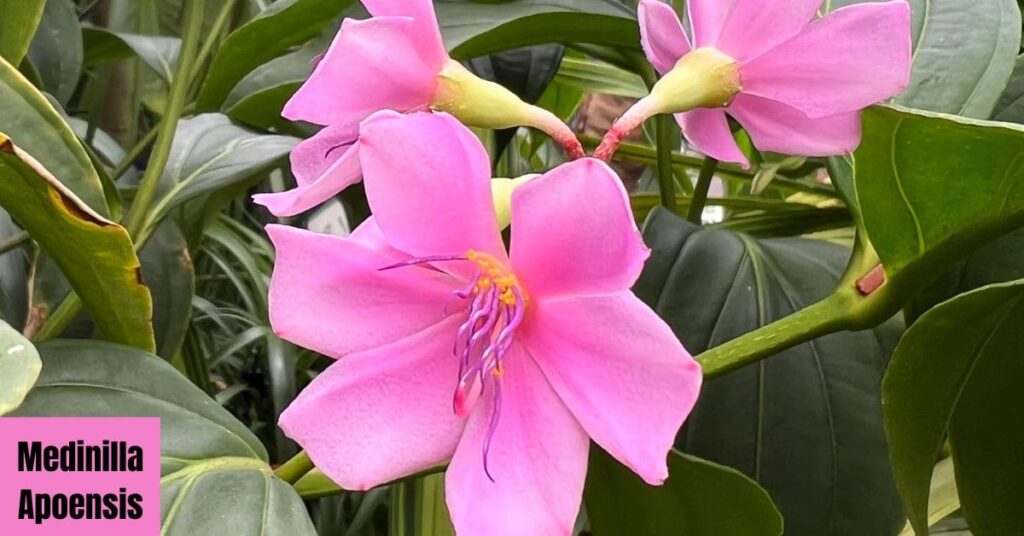
Contents
- 1 Introduction to Medinilla Apoensis
- 2 The Origin and History of Medinilla Apoensis
- 3 Unique Features and Characteristics of Medinilla Apoensis
- 4 How to Grow Medinilla Apoensis
- 5 Caring for Medinilla Apoensis: Watering, Fertilizing, and Pruning Tips
- 6 Common Pests and Diseases of Medinilla Apoensis
- 7 Creative Ways to Display Medinilla Apoensis
- 8 Conclusion
- 9 FAQs
- 10 Q: Can I grow Medinilla Apoensis indoors?
Introduction to Medinilla Apoensis
Welcome to the fascinating realm of Medinilla Apoensis, a plant whose exotic beauty and distinct charm enchantment fascinate people. This gorgeous species will take centre stage in your indoor garden if you want to add a little sophistication and beauty. Come on a voyage as we investigate the intriguing history, unique traits, and crucial maintenance advice for cultivating and preserving the magnificent Medinilla Apoensis. Let’s explore and find out why growing this plant in your green haven is a true gem!
The Origin and History of Medinilla Apoensis
The history of the plant Medinilla Apoensis, which is native to the Philippines, spans several centuries. Its name honours Mount Apo, the nation’s highest peak and the site of its original discovery. The indigenous people of Mindanao have long valued this plant for its exquisite appearance and distinctive qualities.
According to historical accounts, ancient Filipino tribes utilized Medinilla Apoensis for its therapeutic qualities in traditional medicine. With time, its glossy green foliage and eye-catching pink blossoms made it a popular decorative plant.
The unique plant’s attraction grabbed explorers who journeyed into the isolated regions of the Philippines. After studying and growing Medinilla Apoensis, botanists and horticulturists rapidly brought the plant to botanical gardens worldwide.
Medinilla Apoensis is a valued addition to any botanical collection because of its intriguing history and intriguing origins, which still captivate plant enthusiasts today.
Unique Features and Characteristics of Medinilla Apoensis
Because of its distinct qualities and traits, Medinilla Apoensis stands out among other exotic plants. Its vivid pink blossoms, which flow like delicate chandeliers, are likely to enthral any enthusiast for plants. The showy flowers are beautifully contrasted with the glossy, dark green leaves, making for a striking display.
The fact that Medinilla Apoensis is epiphytic—that is, it grows on other plants without becoming parasitic—is one of its most notable characteristics. This makes it fascinating from a botanical perspective and visually stunning. This plant also grows with a beautiful and elegant habit that lends sophistication to any area.
Apart from its visual allure, Medinilla Apoensis is renowned for its durability and versatility.
How to Grow Medinilla Apoensis
Consider cultivating Medinilla Apoensis in your indoor garden to add a hint of exotic charm. This gorgeous plant is indigenous to the Philippines and prefers warm, humid weather.
The first step in growing Medinilla Apoensis well is selecting a potting mix that drains well and holds moisture without getting soggy. Place your plant in a well-lit area with indirect sunlight for best development.
Water your Medinilla Apoensis frequently, ensuring the soil is continuously damp but not drenched. Fertilize with a balanced liquid fertilizer every two to four weeks during the growing season to encourage robust growth and colourful flowers.
This low-maintenance plant requires little pruning; remove any damaged or dead leaves as needed to encourage new growth. Your Medinilla Apoensis will repay you with its eye-catching foliage and exquisite blossoms if given the proper care and attention.
Caring for Medinilla Apoensis: Watering, Fertilizing, and Pruning Tips
You must provide proper care to ensure your Medinilla Apoensis grows and thrives in your house. This exotic plant does not like to sit in water; instead, it prefers regularly moist soil. Ensure the soil drains properly, and water it when the top inch appears dry.
Every four to six weeks, treat your Medinilla Apoensis with a balanced liquid fertilizer to encourage strong growth and lovely blooms. Avoid overfertilizing since this might be detrimental to the plant.
It’s crucial to prune your Medinilla Apoensis to keep it in shape and promote new growth. Remove wasted flowers and dead or yellowing leaves to keep the plant looking its best.
These easy-to-follow guidelines for trimming, fertilizing, and watering your Medinilla Apoensis will help to keep it happy and healthy in your house.
Common Pests and Diseases of Medinilla Apoensis
Growers of Medinilla Apoensis may face frequent obstacles in caring for this lovely plant, including pests and illnesses. Aphids and spider mites are among the bothersome insects that can cling to plants, depriving them of essential nutrients and inflicting harm. Look out for any indications of these little intruders.
A fungal disease called powdery mildew, which can cause white spots on foliage, is another possible problem to be mindful of. It can be delayed by maintaining adequate ventilation and avoiding overhead irrigation. Root rot may develop if a plant’s roots are left in wet soil for an extended period. Ensure your drainage system is in good working order to reduce this danger.
To address these issues, consider applying neem oil for illnesses and pests or organic insecticidal soap for bugs. Check your Medinilla Apoensis frequently for any indications of problems so you can take quick action and maintain the healthy growth of your plant.
Creative Ways to Display Medinilla Apoensis
Searching for unique ways to present your exquisite Medinilla Apoensis? Let’s look at several creative ways to showcase this unique beauty in your house or yard.
Think about placing your chic macramé plant hanger beside a bright window to display your Medinilla Apoensis. Against any background, the pink blooms that cascade down will have a powerful visual impact.
Put your Medinilla Apoensis on a modern plant stand or pedestal to accentuate its beauty and make it the centre of attention in any space for a more understated aesthetic.
If you’re short on room, arrange a few Medinilla Apoensis plants in a cluster on a raised plant stand to create a striking botanical arrangement that gives your room depth and perspective.
Alternatively, you may display your Medinilla Apoensis in a beautiful ceramic pot or woven basket to add rustic charm to its inherent beauty.
Discover the ideal location to showcase your Medinilla Apoensis by using your creativity to present this magnificent indoor or outdoor plant.
Conclusion
The fascinating Medinilla Apoensis has a great deal to offer in beauty and charm as we get to the end of our investigation into this exotic plant. Its glossy foliage and gorgeous pink blossoms make it a true show-stopper in any indoor garden.
We have discovered the keys to cultivating and preserving this unique plant by exploring its history, distinctive characteristics, and maintenance advice. Medinilla Apoensis is a stunning plant that will catch everyone’s eye, regardless of experience level. Its graceful appearance is likely to surprise even the most novice gardener.
Recall that maintaining this tropical beauty may require close attention to detail, but the benefits are well worth the work. Your Medinilla Apoensis will grow and prosper for many years if you give it the proper water, fertilizer, and pruning care. So go ahead and purchase one of these fantastic plants right now; you won’t be sorry!
FAQs
Q: Can I grow Medinilla Apoensis indoors?
A: Medinilla apoensis has adequate light and humidity to grow inside.
Q: How often should I water my Medinilla Apoensis?
A: Water your Medinilla Apoensis once a week or whenever the top inch of soil seems dry to the touch.
Q: What kind of fertilizer should I use for my Medinilla Apoensis?
A: Throughout the growing season, use a half-strength solution of a balanced liquid fertilizer every two to four weeks.
Q: How do I propagate my Medinilla Apoensis?
A: You can divide your plant or take stem cuttings during the growing season.
Remember that patience and care are essential for this gorgeous and exotic plant to flourish as you set off on its adventure with it. You may fully appreciate the beauty of Medinilla Apoensis according to these care and cultivation requirements. Cheers to your successful gardening!






